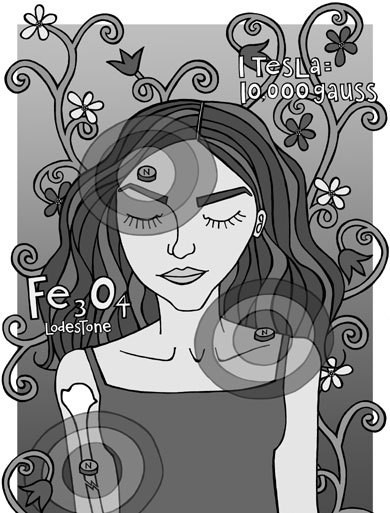Worn as jewelry or incorporated into shoe insoles, mattress and pillow covers, and wearable wraps for the body, magnets are believed by some to enhance well-being and improve symptoms for a variety of ailments. Is there any validity to it? Opinions are, fittingly, polarized.
In the health section of a large bookstore you will find books that say any health benefit from magnets is nonsense, alongside books on natural remedies that list a myriad of conditions for which they are helpful. Clinical trials offer divergent conclusions about the efficacy of magnets for things like reducing pain, improving sleep, treating depression, and hastening wound healing. Dr. Stephen Barrett, writing for Quackwatch (www.quackwatch.org), says, “There is no scientific basis to conclude that small, static magnets can relieve pain or influence the course of any disease. In fact, many of today’s products produce no significant magnetic field at or beneath the skin’s surface.”
Yet many people say magnets have helped them. Dana Scarano is a Rhinebeck-based massage therapist who used magnets for a recurrent hip problem when she danced professionally. “I taped them to my hip at night, and would wake up with significantly less pain, inflammation, and tightness in the joint in the morning.” Some acupuncturists are using magnets on points where they would have placed needles and say they are working as well or better. And the Internet is abuzz with testimonials that sound too good to be true—the most glowing are those presented by companies that manufacture and sell magnets.
Dr. Aruna Bakhru, an internist in Poughkeepsie, helps put this in perspective: “Magnet therapy is not a one-size-fits-all treatment, and it’s not possible to predict who will benefit and who won’t. I believe in them and have tried them myself, but they did nothing for me. I also tried them with a patient who adamantly didn’t believe in them, but whose pain [for a herniated disc] improved immediately with the magnet, and returned when the magnet was taken off.” Bakhru estimates that about one in five of her patients have good results.
a magnet of your own
Magnetite, also known as lodestone, has been used for healing and folkloric rituals around the globe for millennia (Cleopatra is said to have worn one on her forehead). Magnetite is a naturally occurring form of iron oxide whose magnetic properties are thought to be caused by some natural event, like a lightning strike, that set its electrons spinning in the same direction. Today, lodestone remains central to the treatment of ailments, maintenance of health, and for powering magic spells in a diversity of cultures, such as African-American “hoodoo,” curanderas of Latin America, and by natural healers in many countries.
The development of manmade magnets in a variety of strengths and shapes has made them even more accessible, and they are an accepted part of the health and wellness toolkit in India, China, Russia, Canada, and France. In the us, magnet use is on the rise, as people are experimenting with them on their own or with the assistance of a health practitioner experienced in “magnet therapy.”
Magnets for personal use, also known as “permanent” magnets, create a stable magnetic field and come in flexible sheets, bars, or disk-shaped pieces. They are made of iron oxide or alloys of iron’s magnetic neighbors in the periodic table, nickel, boron, and other metals. The “rare-earth” magnets, like those made of neodymium-iron-boron, can be hundreds of times stronger than the commonplace (magnetite-based) magnets. They are used as is or worn on the body as wraps (for elbows, wrists, knees and ankles, forehead, neck, and torso) or jewelry (beads, chains, and pendants).
Using a magnet properly is more complex than just slapping it on. Some magnets are constructed to have the “north” polarity on one side and “south” on the other, while others alternate both kinds in an orderly matrix. Magnetic therapy practitioners say polarity matters, as does strength of the magnet (described in gauss), with low strength (less than 1,000 gauss) being like a “nutrient,” and very high strength (over 3,000 gauss) as a very powerful tool to be used with caution. (For comparison, a refrigerator magnet is about 10 gauss.) But the gauss value of a given magnet does not necessarily reflect its strength, as some vendors imply, since size and composition also matter. And a stronger magnet isn’t always better; it depends on the condition that’s being treated.
Incidentally, magnets are to be avoided during pregnancy and can interfere with pacemakers, automatic internal defibrillators, and implanted insulin pumps. They are also unhealthy for computer disks, audio/video tapes and credit cards, which all store their information on magnetized materials.

















